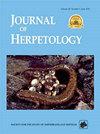无保护的尼罗鳄种群对陆地饮食的依赖
IF 0.8
4区 生物学
Q3 ZOOLOGY
引用次数: 2
摘要
摘要在南非,保护区以外的尼罗河鳄鱼种群正受到威胁。据信,它们主要以鱼类为食,但也会从陆地系统中捕食,这会使它们与人类发生冲突,并阻碍它们的管理。在这里,我们使用稳定的光同位素分析来探索奥利芬茨河、普马兰加省和林波波省未受保护的尼罗河鳄鱼种群的饮食。氮稳定同位素比率是从河流长度(±430公里)沿线的鱼类和鳄鱼种群中获得的。集水区受到严重污染,营养热点的d15N值升高,这为跟踪鳄鱼对鱼类d15N纵向分布的营养反应提供了基础。鳄鱼对鱼类种群d15N值的变化没有反应,基于特定体型饮食对组织歧视因素的饮食预测表明存在非水生食物基础。这些结果表明,作为保护区外为数不多的可行尼罗河鳄鱼种群之一,陆地饮食依赖性给它们的保护带来了独特的挑战。本文章由计算机程序翻译,如有差异,请以英文原文为准。
Terrestrial Diet Dependence in an Unprotected Nile Crocodile (Crocodylus niloticus) Population
Abstract. Nile Crocodile (Crocodylus niloticus) populations that exist outside of protected areas are under threat in South Africa. They are believed to predominantly feed on fish, but they also take prey from the terrestrial system, which brings them into conflict with humans and hampers their management. Here, we use stable light isotope analysis to explore the diet of an unprotected Nile Crocodile population in the Olifants River, Mpumalanga and Limpopo Provinces. Nitrogen stable isotope ratios were obtained from fish and crocodile populations along the length (±430 km) of the river. The catchment is severely polluted with elevated d15N values at nutrient hotspots, which provides a basis for tracking the trophic response of crocodiles to the longitudinal profile of fish d15N values. Crocodiles did not respond to changes in the d15N values of fish populations and dietary predictions based on size-specific diet to tissue discrimination factors suggests a nonaquatic food base. These results suggest terrestrial diet dependence in one of the few viable Nile Crocodile populations from outside protected areas, posing unique challenges to their conservation.
求助全文
通过发布文献求助,成功后即可免费获取论文全文。
去求助
来源期刊

Journal of Herpetology
生物-动物学
CiteScore
1.60
自引率
0.00%
发文量
45
审稿时长
6 months
期刊介绍:
The Journal of Herpetology accepts manuscripts on all aspects on the biology of amphibians and reptiles including their behavior, conservation, ecology, morphology, physiology, and systematics, as well as herpetological education. We encourage authors to submit manuscripts that are data-driven and rigorous tests of hypotheses, or provide thorough descriptions of novel taxa (living or fossil). Topics may address theoretical issues in a thoughtful, quantitative way. Reviews and policy papers that provide new insight on the herpetological sciences are also welcome, but they must be more than simple literature reviews. These papers must have a central focus that propose a new argument for understanding a concept or a new approach for answering a question or solving a problem. Focus sections that combine papers on related topics are normally determined by the Editors. Publication in the Long-Term Perspectives section is by invitation only. Papers on captive breeding, new techniques or sampling methods, anecdotal or isolated natural history observations, geographic range extensions, and essays should be submitted to our sister journal, Herpetological Review.
 求助内容:
求助内容: 应助结果提醒方式:
应助结果提醒方式:


